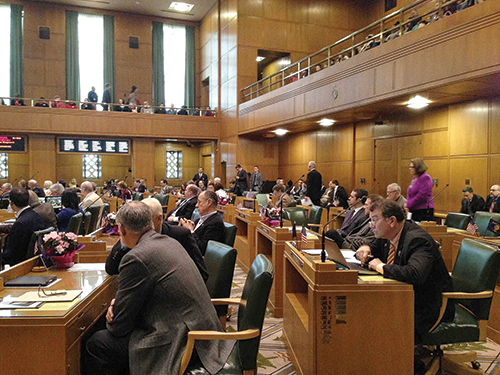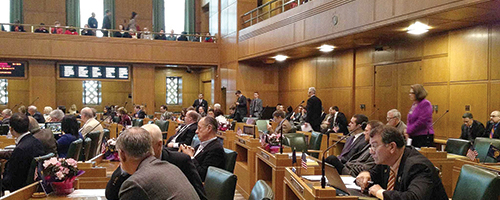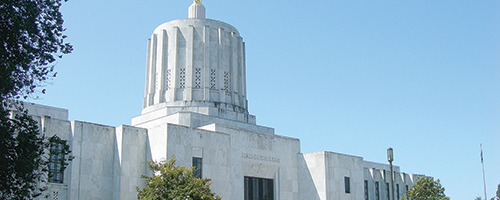New legislation in Salem could have a significant impact on the way universities are run in Oregon. Senate Bill 270 and House Bill 2149 both address the establishment of institutional boards at the state’s public universities. If passed, this legislation would see a board of directors created at both Portland State and the University of Oregon, allowing many decisions to be made at a university level.
Legislature considers establishment of university boards

New legislation in Salem could have a significant impact on the way universities are run in Oregon.
Senate Bill 270 and House Bill 2149 both address the establishment of institutional boards at the state’s public universities. If passed, this legislation would see a board of directors created at both Portland State and the University of Oregon, allowing many decisions to be made at a university level.
More of Oregon’s public universities would be able to follow suit later on if such governance was deemed appropriate.
The bills’ supporters say that implementation of these boards would allow the universities greater institutional flexibility and freedom in controlling elements of operations like salaries and benefits for faculty and staff, tuition rates for students and land purchases for future growth.
Supporters add that universities with institutional boards would be better able to conduct fundraising by encouraging philanthropic donations and through the sale of university bonds.
The legislation comes amid a wider effort to reform higher education in the state, namely in pursuit of Gov. John Kitzhaber’s 40-40-20 plan. The plan, which went into effect in January of 2012, aims to see 40 percent of adult Oregonians with a bachelor’s degree, 40 percent with an associate’s degree or vocational certificate and the remaining 20 percent with a high school diploma by 2025.
In written testimony submitted to a May 2012 special committee on university governance at the Capitol, PSU President Wim Wiewel argued in favor of such a shift at PSU, saying that the university needs an institutional board with a mandate that allows for an explicit focus on the university’s needs, as well as the ability to act on them, while reflecting the interests of the region.
“This governance model,” Wiewel said, “offers PSU the best opportunity to succeed and help the state meet its 40-40-20 goal.”
According to the text of the bills, the university boards would consist of 11 to 15 members appointed by the governor from a pool of nominees selected by the university.
The governor’s selections would be forwarded to the senate for confirmation. Board members would serve four-year terms.
“The state board of higher education supports institutional boards,” said Diane Saunders, the director of communications for the Oregon University System, adding that the current legislative process has been in motion for about a year and a half.
In 2009, OUS commissioned a white paper from David Frohnmayer, president emeritus of U of O. Titled “The Coming Crisis in College Completion,” the report outlines “serious dangers in Oregon’s struggle to provide adequate higher education opportunities for [Oregon’s citizens].”
According to Saunders, a review that followed the paper’s publication examined numerous potential approaches to repairing the higher education situation in the state, and OUS is supportive of the current legislative process and reform efforts. “We have to look at other ways of doing business,” she said.
The legislation does not see support from all corners, however.
Those who oppose the bills as they’re written say they preclude students and staff from involvement in the administrative process by barring them from appointment to the institutional boards. Those unconvinced by the present effort have also said that institutional boards in general could end up bloating costs for students—effectively reducing Oregonians’ access to higher education.
Patricia Schechter, a history professor at PSU and an executive council member of the university’s chapter of the American Association of University Professors, said that while there are many possibilities to consider with regard to university governance a silver bullet is unlikely.
“There’s no consensus for best practices,” Schechter said, adding that neither PSU-AAUP nor the AAUP’s coalition partners endorse the bill as written.
“We could be open to endorsing if we saw a board composition package that was exciting and inclusive,” she said. This would mean voting rights for faculty, staff and students.
PSU’s student government, in coalition with the Oregon Students Association, is also opposed, according to David Coburn, the Associated Students of Portland State University’s director of legislative affairs.
Coburn is particularly concerned that students aren’t guaranteed representation on the board.
“Students are actually a really essential part of any university process,” he said.
A key part of the conversation, he added, has revolved around making sure that the actions of ASPSU and its partners benefit PSU while remaining mindful of their effects on the state of Oregon. “I really don’t believe that the bills that have been proposed do those sorts of things,” he said.
Thursday marked the legislative deadline for bills to advance beyond their original committees or risk dying this session. As of this writing, SB 270 has seen a number of amendments that have addressed technicalities within the bill. The new version, SB 270-A, has been unanimously approved by the Senate Committee on Education and Workforce Development. According to a press release, the legislation “now moves to the Joint Committee on Ways and Means, where it will receive further work related to the state budget.” SB 270-A’s partner bill in the house, HB 2149, is in the House Committee on Rules, where it may see further work.







In less than 900 words, Coby Hutzler succinctly tells what’s happening now with legislation authorizing institutional boards, but his account leaves out a key fact: the Oregon State Board of Higher Education has 2 faculty and 2 students among its 13 voting members. If the new the new institutional boards will decide “salaries and benefits for faculty and staff, tuition rates for students and land purchases for future growth,” it’s essential to maintain the tradition of stakeholder representation by having seats on them for faculty, staff, and students. PSU’s Faculty Senate passed a resolution in support of faculty representation and testified for it to the House Higher Education Subcommitte in March. We need emails to tell the legislation that students, faculty, and staff should have a voice on the institutional boards.